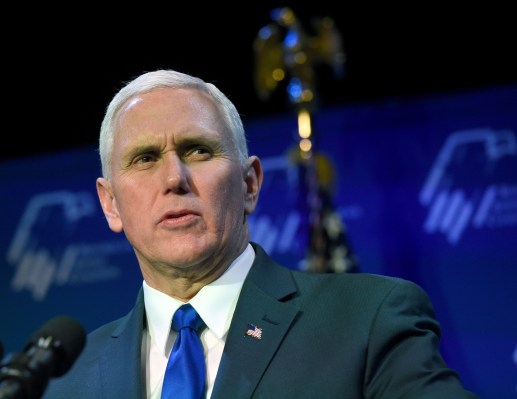In a speech before the Department of Defense at the Pentagon today, Vice President Mike Pence outlined the broad contours of the new Space Force that the Trump administration wants to create as the sixth branch of the U.S. military.
Emphasizing the need to both further militarize and privatize space as a new war-fighting domain, Pence stressed that the new branch of the military is targeted for a 2020 implementation date. The administration is pushing for $8 billion in new space spending.
“While other nations increasingly possess the capability to operate in space, not all of them share our commitment to freedom, private property and the rule of law,” said Pence. “As we continue to carry American leadership in space, so also will we carry America’s commitment to freedom into this new frontier.”
Pence cited threats from North Korea, Russia, China and Iran to the safety of the U.S. space program.
Newer threats include the Chinese government’s 2007 launch of a satellite-destroying missile and the development of hypersonic missiles that can evade U.S. missile defense capabilities. The Chinese government has set up a separate division within its own military to address space as a war-fighting domain, Pence said. “Our adversaries have transformed space into a war-fighting domain already.”
“It is not enough to have an American presence in space. We must have American dominance in space,” Pence said quoting the president. “What was once peaceful and uncontested is now crowded and adversarial.”
To advance its goals of creating the new Space Force, the Trump administration had commissioned the Department of Defense to issue a report on the necessary steps to create the new military branch.
The creation of a new branch of the military — the first since the Air Force was created in the wake of World War II in 1947 — could require a significant reorganization of the Pentagon. And some officials within the military and national security communities fiercely oppose the idea. The Air Force in particular is opposed to the idea, because it might lose key responsibilities. The proposal would also need congressional approval.
In a report that will be issued later today, the DOD outlined four steps.
The first is the creation of a United States Space Command that will coordinate the nation’s space-fighting capabilities. Pence likened it to the special operations command established in the 1980s that provided unified command and control capabilities for mobilizing terrestrial air, sea and land forces. “This new command structure for the physical domain of space, led by a four-star flag officer will… develop the space war-fighting doctrine and tactics of the future.”
As part of the space plan, the Department of Defense will also create a new space operations force that will be “an elite group of joint war fighters specializing in the war-fighting domains of space,” according to Pence. They’ll support the space combat and command and carry out space missions.
Third, a new joint organization called the Space Development Agency will be created to develop new technologies for the space force. “While our adversaries have been busy weaponizing space, we have been bureaucratizing it,” Pence said. He pointed to the creation of the intercontinental ballistic missiles and the Navy’s nuclear fleet as examples of American military innovation and achievement from past initiatives.
(It’s a good thing he didn’t bring up the Air Force’s “half-a-trillion-dollar drone boondoggle” of a new fighter plane.)
Finally, the process of creating the new organization will require oversight, which will include the creation of a new civilian position that will report to the secretary of defense, Pence said. That position will be called the assistant secretary of defense of space.
“Just as we’ve done in ages past, the United States will meet the emerging threats on this new battlefield,” Pence said. “The time has come to establish the United States Space Force.”
